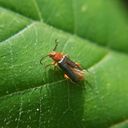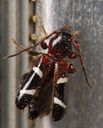Callidiini
Callidiini
Classification
- Phylum: Arthropoda
- Subphylum: Hexapoda
- Class: Insecta
- Order: Coleoptera
- Suborder: Polyphaga
- Superfamily: Chrysomeloidea
- Family: Cerambycidae
- Subfamily: Cerambycinae
- Tribe: Callidiini
Pronunciation
How to pronounce Callidiini: /kælɪˈdaɪɪnaɪ/
These audio files are automatically generated. While they are not always 100% accurate, they are a good starting point.
Images






Summary
Callidiini is a tribe of longhorn beetles notable for their long antennae and variety of genera, comprising over 180 species. They play significant ecological roles as decomposers in forest environments.
Physical Characteristics
Longhorn beetles, generally characterized by long antennae that can be as long as or longer than the body.
Identification Tips
Look for elongated bodies and prominent, long antennae. Specific characteristics can vary among genera.
Habitat
Primarily found in wooded areas and forests where they are often associated with decaying wood.
Distribution
Widespread across North America and Eurasia, with 60 species in 11 genera reported in specific areas, and approximately 70 species across 14 genera in the New World.
Diet
Larvae typically feed on the wood of trees and shrubs; adults may feed on nectar or pollen.
Life Cycle
The life cycle includes egg, larval, pupal, and adult stages, with larvae developing in wood.
Reproduction
Females lay eggs in or on decaying wood; larvae develop within the wood before pupating and emerging as adults.
Ecosystem Role
These beetles are important decomposers, aiding in the breakdown of dead wood and contributing to nutrient cycling in forest ecosystems.
Economic Impact
Some species may cause damage to timber and live trees, impacting forestry and landscaping.
Collecting Methods
- Trapping using baited traps
- Hand collecting from host plants or wood
Preservation Methods
- Pinning
- Alcohol preservation
Evolution
Part of the longhorn beetle family, with a long evolutionary history and adaptation to woody habitats.
Similar Taxa
Misconceptions
Some people may confuse longhorn beetles with other beetles due to their elongated appearance but they can be distinguished by their long antennae.
Tags
- Callidiini
- longhorn beetles
- Cerambycidae
- insects
- beetles